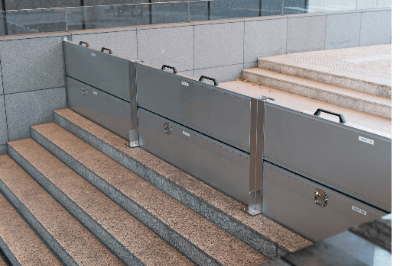What Is a Water Barrier

A water barrier is a material that prevents water from entering a building.
Water barriers can be broadly classified into two types: those used in civil engineering and construction, and those used to prevent flooding in buildings. Water barriers are used in civil engineering and construction, and are placed at the joints of concrete structures. They are used in the construction of underground buildings and civil engineering works for dams, tunnels, and elevated bridges.
Water barriers used to protect buildings from flooding are used to protect houses and other structures from flooding caused by heavy rains, such as typhoons and guerrilla rains. Water barriers of this type come in a variety of sizes, from small-scale ones for ordinary houses to large-scale ones for preventing rivers from overflowing.
Uses of Water Barriers
Water barriers are broadly classified into two types: water barriers for civil engineering and construction materials and water barriers used to prevent flooding of buildings and other structures.
1. Water Barriers for Civil Engineering and Construction Materials
Water barriers for civil engineering and construction materials are placed at the joints of concrete structures. When concrete structures are built, concrete is first poured as the foundation, and then concrete is poured again after the concrete has dried, a process known as jointing.
Water barriers are placed at the joints. They are used for concrete structures in various environments where water is generated, such as underground buildings, dams, tunnels, and seawalls.
2. Water Barriers Used for Flood Control in Buildings, etc.
Water barriers used to prevent flooding in buildings and other structures are placed in locations where water tends to penetrate to prevent flooding. Specific locations include subway entrances and exits, store entrances and exits, building and apartment entrances, and underground parking lots. Water barriers used to prevent flooding are also used on a large scale to prevent flood damage by being placed in areas where there is a high possibility of river flooding.
Principle of Water Barriers
The principle of water barriers varies depending on the type.
1. Water Barriers for Civil Engineering and Construction Materials
Water barriers for civil engineering and construction materials are placed at concrete joints. At joints, the concrete foundation, which is already dry, and the newly placed concrete do not mix, and a joint is formed between them. Since water can seep through these joints, a jointing process is used to fill the joints.
A common method is to use metal water barriers for this joint treatment. Water barriers are placed at the joints before the concrete is poured. The metal water barrier protrudes vertically from the surface of the concrete foundation and penetrates the concrete to be placed next. Water barriers prevent water from entering the joint between the two.
2. Water Barrier Used for Flood Control in Buildings, Etc.
Water barriers used to prevent flooding in buildings are placed at the entrances of buildings to prevent flooding. Lightweight and sturdy aluminum plates are used for this purpose.
Types of Water Barriers
This section describes the types of water barriers used to prevent flooding of buildings and other structures. The main types include door type, motorized type, manual type, sliding type, swinging type, and removable type.
1. Door Type
As the name suggests, the water barrier is shaped like a door.
2. Motorized Type
This type of water barrier is normally stored inside buildings, etc., and is electrically activated to stop water when in operation.
3. Manual Type
The manual type has the same shape as the electric type, but the installation is done by hand.
4. Sliding Type
In the sliding type, the water barrier moves horizontally, while in the swing type, it has a vertical axis of rotation and pivots to move the water barrier into position.
5. Detachable Type
The detachable type can be removed and installed only when necessary. It requires storage space but has advantages such as low cost and almost no maintenance.
Other Information on Water Barriers
Use of Water Barriers
In recent years, houses and other structures have frequently been flooded by typhoons, torrential rains, and other sudden disasters. In light of this situation, information on flood prevention measures that can be taken at home has been disseminated mainly by local governments, and water barriers for home use have been attracting attention. Water barriers for home use are effective in the form of longboards of furniture such as tables, which are installed and secured at the entrances and exits of houses and buildings.
In this case, the width of the board should cover the entire width of the doorway and the height of the board should be adjusted to about knee-high. The board must be securely fastened so that it will not move. Waterbags, blocks, polyethylene tanks, stepladders, etc. can be used to secure the boards in place. Water barriers can also be improved by wrapping the board and the fixing material in a blue sheet and using the entire sheet as a water barrier.
Various other water barriers that can be used at home are available from various manufacturers. Water barriers available on the market come in a variety of shapes and sizes, depending on where they are to be installed. For example, some have a structure that can be easily attached to the sash frame of a house, allowing for quick installation work.